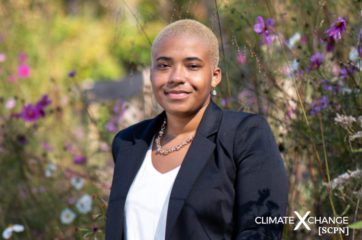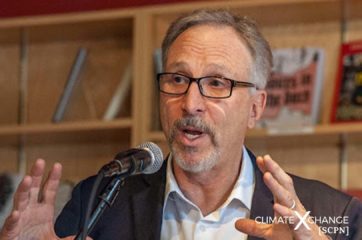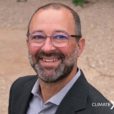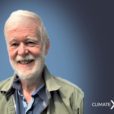All across the country, members of our State Climate Policy Network (SCPN) are fighting to make an impact on climate change in their communities. We have individuals in our Network from all 50 states, each experiencing climate change differently in their local areas and finding unique solutions to build resiliency efforts.
Camille Manning Broome is the President & CEO of the Center for Planning Excellence (CPEX). CPEX works to advise Townships, Parishes, and the State of Louisiana on planning and modeling master plans. CPEX works to create a livable and resilient future for Louisiana.
Camille Manning Broome also serves on Governor Edward’s Climate Initiatives Task Force and is the co-chair of the Land Use, Buildings, and Housing Committee.
Sarah Xu
Could you introduce yourself and share what motivates you to work on planning for Louisiana’s climate future?
Camille Manning Broome
I’m Camille Manning Broome, President and CEO of the Center for Planning Excellence (CPEX). While my undergraduate degree was in art history, I became inspired by how our culture is tightly linked to our natural and built environment. This led to an interest in climate change impacts, and I decided to pursue graduate studies at the School of the Coast and Environment at Louisiana State University, where I began work on climate change adaptation.
During my graduate work, I worked with a Native American fishing community outside of the levee protection system in lower Plaquemines Parish in Louisiana. I began focusing on risk perceptions and relocation planning for high risk communities. This was pre-Hurricane Katrina and Hurricane Rita. I saw the need to help communities chart a path forward amidst all of the environmental challenges they were facing, and in doing so, help set the table for more voices to contribute to Louisiana’s future. As you know, in Louisiana, we’re really on the front lines of so much of this — environmental degradation, sea level rise and flooding, temperature changes. All of this bears on the global transition from a high- to low-carbon economy, which has huge implications for our state economy. Many of our people are vulnerable to these shifts because Louisiana has such a high poverty rate, so I try to be a champion for the people and the communities of Louisiana in my work.
Sarah Xu
What are some specific challenges that Louisiana faces in terms of climate and the environment?
Camille Manning Broome
One of the main challenges is human migration. There is currently no plan in place for what that migration should ideally look like. In Louisiana it’s highly means-based — people with resources move out of high-risk places first. The people left behind don’t have the resources to move, and they rely on in-place social networks to get by. When those networks start to break up, it’s a domino effect of bad outcomes, from an individual to systemic level. We can’t just say ‘this is someone else’s problem’ — it’s incumbent on all of us who work in this space to help our states and our congressional delegations understand the needs around population movement and migration. This problem is too big for local governments to figure out on their own.
From a planning perspective, we have to think about how to equip the receiving communities. Beyond implementing good planning practices, they need support to build the infrastructure they will need to be able to serve incoming populations, some of which will be high-needs because of traumas and hardships they’ve endured. People who are already experiencing poverty, discrimination, abuse or chronic health issues often do not have the resources needed to adequately manage climate threats and are essentially forced to relocate under duress. Not surprisingly, there’s a large-scale mental health crisis associated with this as well. We’ve seen this time and time again in Louisiana after natural disasters like Hurricanes Katrina and Rita, which displaced thousands of people, and more recently the Great Floods of 2016. Downstream effects include higher rates of anxiety, depression, suicide, and babies born with opioids in their system — we see a spike after every disaster. Domestic abuse cases increase too. It is evident that displacement and migration is a system-wide issue that communities need resources to manage.
Sarah Xu
Thank you so much for sharing that. You are the CEO of the Center for Planning Excellence. Could you share about what your organization does and how it aims to create a climate resilient future?
Camille Manning Broome
Our organization grew out of a need for vision and a need for planning. Historically, Louisiana has always been a strong private property rights state, and so there wasn’t a lot of shared vision around planning for land and water management. Hurricanes Katrina and Rita exposed those vulnerabilities, and it was broadcasted globally. It was really devastating for Louisiana. That ultimately led to some of the governance shifts that CPEX has been a part of. In 2006, we led the Louisiana Speaks Regional Recovery Plan, which aimed to help all of our coastal communities and our state think much larger about the vision for the future.
You can’t talk about community vision without incorporating the risk of climate change, since our state is so vulnerable. We began working independently with parishes across the state to do comprehensive master plans, many for the first time. CPEX also helps with master plan implementation, since so many of our local governments don’t have the capacity or staff to follow these large-scale implementation road maps. We’ve now worked in over 50 communities across Louisiana.
At the state level, we’re working hand-in-hand with agencies on key policies such as our adaptive governance initiative, which helps state agencies integrate a climate change resilience lens in their strategic plans. Through executive order, we have a Chief Resilience Officer and resilience liaison in each agency, which indicates the priority this work has received at the state level. CPEX is also a partner on the Louisiana Watershed Initiative, working across five agencies to help align flood risk reduction policies and programs. And finally, my team and I are serving on the Climate Initiative Task Force, where we’ve been supporting the governor across the work on various subcommittees. Right now, we’re all developing recommendations to be included in the State’s Climate Action Plan.
Sarah Xu
How does your planning and community engagement background inform your work with the Climate Initiatives Task Force?
Camille Manning Broome
The Task Force is charged with having some really difficult conversations and coming up with a number of strategies to help us reach the goal of net-zero by 2050. Community input is key to that. Part of that is also making sure that there’s a spectrum of representation on the Task Force itself. So when you look at the Task Force and subcommittee membership, you see individuals of all walks of life and backgrounds contributing to the conversation. In addition, the state’s trying very hard to make this a public and open process. CPEX, alongside other civic-minded nonprofit organizations, is doing outreach across our networks to really encourage participation and contributions to the recommendations. Anyone can submit a recommendation to the state using the action template. It’s imperative for the long-term strength of the plan to get as much input as possible.
Sarah Xu
Engaging stakeholders seems to be a large part of your work, especially with Louisiana’s Strategic Adaptations for Future Environments (LA SAFE). How do you approach this work?
Camille Manning Broome
We are a mission-driven organization to enhance the quality of life, and champion the power of good planning, across all Louisiana communities. We can’t achieve our mission unless the right people are sitting at the table and the table is open to all. That’s the only way to build capacity and give communities the tools they need so that they can be champions and leaders of their plan. It’s never our plan. We are the facilitators to hear the needs, hopes, and desires for the future and then use our expertise to develop plans that residents can see themselves in. We work with local community groups to make sure that there’s a lot of outreach and engagement and everyone has an opportunity to participate. We are very flexible and adaptable in how we do our outreach and engagement in each community — we meet you where you are and we listen to the people that know their community best. I think that’s really the key.
In regards to LA SAFE, we lead the outreach and engagement in two parishes — St. John the Baptist and Terrebonne — and were the lead authors alongside Waggonner & Ball for all six of the plans. This was a critical initiative. We had the state and philanthropy organizations, through the Foundation of Louisiana, leading a large team of nonprofits, private firms, and resident experts discussing the real risks our communities are facing across the state. We needed significant community input as we were developing adaptation plans for high, medium and low risk communities. It’s not easy to sit down with a high-risk community and plan what that community will look like 25-50 years due to sea level rise. Unfortunately, in many cases, it’s no longer viable to live there permanently and the community turns into more of a recreational area. If we do not have transparency and good governance, we will never be able to accomplish what community members desired through that effort. A lot of creativity happens when you are facing the loss of identity, place, and culture.
Sarah Xu
In engaging local stakeholders, what has been the biggest takeaway that policymakers should know about planning for Louisiana or planning for other coastal communities?
Camille Manning Broome
I always say, people support what they help create. And so it’s always interesting to me that policymakers submit bills, even at the local level, without getting any input at all. They inevitably receive a lot of backlash because they didn’t get insight from the people that it would impact. If you want your plan to become a reality, you have to engage with people who have a vested interest in the outcomes — whether that’s zoning ordinances or big programmatic and funding shifts. Implementation only happens when people support the policy, which means they have to have a hand in creating it.
Sarah Xu
Thank you so much for sharing that. If someone, whether in Louisiana or across the United States, is interested in learning more about your work, the work of the task force, and how to support Louisiana’s environmental community, how can they get involved?
Camille Manning Broome
Right now, individuals can support the Climate Initiatives Task Force by submitting recommendations, which are due by April 30. After that, there will be an open window for comments on the draft plan throughout the rest of the year. We always encourage people to join in on the public meetings.
At CPEX, we’re always looking to exchange knowledge with other people across the United States and beyond doing this work. We’d welcome a call or email! If you want to learn more about our work, we have a number of resources and instructional materials on our website — including games and activities. One activity we created is called “Water You Gonna Do?,” and it’s a really, really fascinating activity that educates about the hard decisions that are made around and within a watershed.
Anyone can use these activities in their own community. A lot of our resources are specifically targeting and responding to the needs of Louisiana communities, but they are universally applicable anywhere — especially where there is high risk around water issues and a lack of planning capacity at the local level.
We also put on our annual Smart Growth Summit where we will discuss a lot of these issues with thought leaders from across the globe. I encourage everyone to attend — it’s virtual again this year.
Sarah Xu
What words of advice do you have for others who want help create a climate resilient future across the country?
Camille Manning Broome
It has never been more critical to have an equity lens when we’re setting the table with scientists, engineers, architects, planners, public policy decision makers, and community members. We have to think differently about our future, and it’s going to take all of us to do that. Our challenges are not insurmountable. The key to addressing them is coming together, having a conversation around shared values, and making decisions based on those values. The status quo isn’t going to work anymore. We already know that our infrastructure and systems will not withstand the pressures of climate change as-is. First, we must understand what’s happening and how we can align our networks around shared values and shared goals. Going back to the equity lens, we know that a large portion of our population was left out of our previous economy. While we’re building a more resilient future, and examining migration issues, the goal should be pursuing a just transition that enables a high quality of life for everyone. None of this will happen without centering equity and justice in all of our conversations around climate resilience.
Sarah Xu
Thank you so much for your work on climate and environmental issues in Louisiana!
Camille Manning Broome
Thank you Sarah for your leadership on climate! It was nice to chat with you. And I’m glad that we’ve made this connection.









